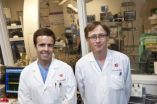(Press-News.org) OTTAWA, October 3, 2012 – A new ground-breaking technology was recently used at the University of Ottawa Heart Institute (UOHI) where two cardiologists, Dr. David Birnie and Dr. Pablo Nery, implanted a new innovative leadless defibrillator, the subcutaneous implantable cardioverter defibrillator (S-ICD), to a 18 year-old patient. Under Health Canada's special access program, this was only the third time this new type of ICD had been implanted in Canada.
Conventional defibrillators, known as transvenous defibrillators, are implanted with wires, called the leads, that snake through veins into the heart. When the defibrillator identifies any dangerous heartbeat, it delivers a shock through the wires to return the heart to its normal rhythm and allow it to get back to pumping blood steadily throughout the body.
Not all patients are suitable for a conventional defibrillator. In some with congenital heart problems, there is no way to advance the leads into the heart through the veins. Also, those wires may pose a danger due to the risk of blood clots or infection. Patients often have to undergo a more complex and invasive surgery to attach the leads to the outer layer of the heart muscle in order to benefit from the use of a defibrillator
Conventional ICDs use leads that run from the device through major veins to an anchor point in the heart. These transvenous leads can cause problems in the long term. Despite decades of design improvements, leads can malfunction, break or stop working. Known as lead failure, this results in either inappropriate shocks or lack of proper regulation of the heartbeat. What's worse is that failed leads often must be removed, which poses serious risks to the patient.
What makes the new device special is that it is entirely subcutaneous. No part of it actually touches the heart. Instead, an electrode is implanted just under the skin near the heart. The defibrillator is connected to the electrode, and monitors the heartbeat at all times. If needed, it delivers a shock to the heart muscle to restore its normal rhythm.
The goal of the subcutaneous ICD is to potentially reduce or eliminate these problems. "The subcutaneous ICD provides effective therapy for patients who are either not eligible for or are at high risk with a traditional ICD. Such patients may now be able to receive protection from a subcutaneous ICD without the risks associated with the standard leads," explained Dr. Nery.
That made the 18-year-old recipient of the S-ICD at the Heart Institute a perfect candidate. "The S-ICD offers advantages for particular patient sub-groups," said Dr. Nery. "This technology is now an alternative for young patients, in part because lead extraction can be avoided down the road."
Another advantage is more aesthetic in nature but, nonetheless, important for young people. A conventional transvenous defibrillator sits on the front on the chest, just under the collarbone, and is easy to see. The S-ICD, in comparison, is implanted to the side, under the patient's arm, and with a much smaller incision than with the transvenous defibrillator. That, said Dr. Nery, is an important consideration for many patients in terms of body image and quality of life.
INFORMATION:
INFORMATION
Vincent Lamontagne
Senior Manager, Public Affairs
University of Ottawa Heart Institute
613-761-4427
613-899-6760 (cell)
vlamontagne@ottawaheart.ca
Innovative new defibrillator offers alternative for regulating heart beat
2012-10-03
ELSE PRESS RELEASES FROM THIS DATE:
City of Ottawa sits atop soil, geologic features that amplify seismic waves
2012-10-03
Engineers and city planners study surface geology in order to construct buildings that can respond safely to earthquakes. Soft soil amplifies seismic waves, resulting in stronger ground motion than for sites built over bedrock. This study examines the local site response for the city of Ottawa, and the results indicate seismic waves may amplify ground motion greater than expected or referenced in the National Building Code of Canada.
Current knowledge of the earthquake activity in Ottawa area is based on less than 200 years of reported felt events and approximately ...
New Queen's University Belfast plasma jet gives 'cold' shoulder to superbugs
2012-10-03
Scientists at Queen's University Belfast have developed a new technique which has the potential to kill off hospital superbugs like Pseudomonas aeruginosa, C. difficile and MRSA.
As revealed in the most recent edition of leading journal PloS One, the novel method uses a cold plasma jet to rapidly penetrate dense bacterial structures known as biofilms which bind bacteria together and make them resistant to conventional chemical approaches.
The new approach developed by scientists in the School of Mathematics and Physics and the School of Pharmacy at Queen's passes electrical ...
Nursing outlook celebrates 60 years by publishing research on nurses in the media with UCLA
2012-10-03
St. Louis, MO, October 3, 2012 -- Historical impact and modern media stereotypes of nurses offer a fascinating contrast in the September/October issue of Nursing Outlook, published by Elsevier, the leading provider of scientific, technical and medical information products and services. Nursing Outlook celebrates 60 years of leading the nursing field in 2012 with two special issues.
"Supplement Issue: Nursing and the Media"
Millions of viewers watch nurses being portrayed on TV shows, news and movies. Yet, many of these portrayals display an outdated and incorrect image ...
New gender benchmarking study finds numbers of women in science and technology fields alarmingly low
2012-10-03
New York, October 3, 2012 – In the first study of its kind, researchers have found that numbers of women in the science, technology and innovation fields are alarmingly low in the world's leading economies, and are actually on the decline in others, including the United States. The study maps the opportunities and obstacles faced by women in science across the US, EU, Brazil, South Africa, India, Korea and Indonesia. It was conducted by experts in international gender, science and technology issues from Women in Global Science & Technology and the Organization for Women ...
Cardiac medication may reduce stiffness caused by certain muscle diseases
2012-10-03
Mexiletine, a decades-old drug previously used to treat abnormal heart rhythms, has been used to alleviate the symptoms of patients with nondystrophic myotonias (NDMs), rare diseases that affect the skeletal muscle and cause functionally limiting stiffness and pain.
The preliminary research, published today in The Journal of the American Medical Association, shows that taking mexiletine can improve patient-reported stiffness.
NDMs are estimated to affect about 1 in every 100,000 people. They are not life-threatening, but can be debilitating, as patients' muscles contract ...
Who was TV's first anchorman? IU professor's research finds it wasn't Walter Cronkite
2012-10-03
BLOOMINGTON, Ind. -- No kidding: The history of the first anchorman may have more to do with Will Ferrell than people might think, according to new research by a journalism historian at Indiana University.
While Ferrell is best known for playing Ron Burgundy in the 2004 comedy "Anchorman," he also famously parodied "Jeopardy" game show host Alex Trebek. Research by Mike Conway, an associate professor of journalism at IU, has found that the first "anchor man" was John Cameron Swayze, then a regular on the 1948 quiz show, "Who Said That?"
Some today may remember Swayze, ...
Discrimination from one's manager really bites
2012-10-03
Mental health workers are more likely to be depressed or anxious when they experience discrimination from their managers than when it comes from patients, a study has found.
Discrimination from the patients' visitors also causes more distress than discrimination from the patients.
A research team led by Professor Stephen Wood at the University of Leicester's School of Management looked at the effects of prejudice, including sex, racial and age discrimination, from different groups of people on mental health workers.
The study, funded by the Department of Health ...
Warning, automatic braking systems on autos will help save lives, research predicts
2012-10-03
The second highest cause of automobile crashes is rear-end collisions – 17 percent. Thousands of people die. The solution? "It is simple," said Clay Gabler, a professor of biomedical engineering at Virginia Tech. "Slow the striking vehicle."
The concept is simple. Execution is complex and expensive. But in a life-and-death scenario, it is worth the investment, agree Gabler and Kristofer Kusano of Herndon, Va., a doctoral student in mechanical engineering. In affiliation with the Virginia Tech-Wake Forest Center for Injury Biomechanics and the Virginia Tech Transportation ...
Memory and thought-process training show promise in managing breast cancer symptoms
2012-10-03
INDIANAPOLIS -- A new Indiana University study is the first of its kind to show it may be possible to improve memory and thought process speed among breast cancer survivors.
Diane M. Von Ah, Ph.D., R.N., assistant professor at the IU School of Nursing and a researcher at the Indiana University Melvin and Bren Simon Cancer Center, and colleagues studied two different treatment options for breast cancer survivors because they often report problems with memory or feelings of mental slowness, which can lead to depression, anxiety, fatigue and an overall poorer quality of life. ...
The brief but violent life of monogenetic volcanoes
2012-10-03
BUFFALO, N.Y. -- A new study in the journal Geology is shedding light on the brief but violent lives of maar-diatreme volcanoes, which erupt when magma and water meet in an explosive marriage below the surface of the earth.
Maar-diatremes belong to a family of volcanoes known as monogenetic volcanoes. These erupt just once before dying, though some eruptions last for years. Though not particularly famous, monogenetic volcanoes are actually the most common form of land-based volcano on the planet.
Despite their number, monogenetic volcanoes are poorly understood, said ...




